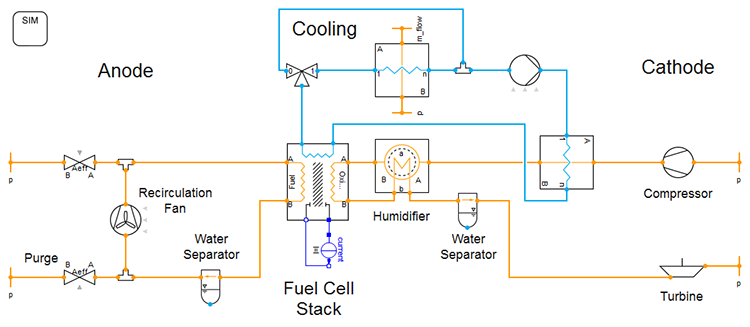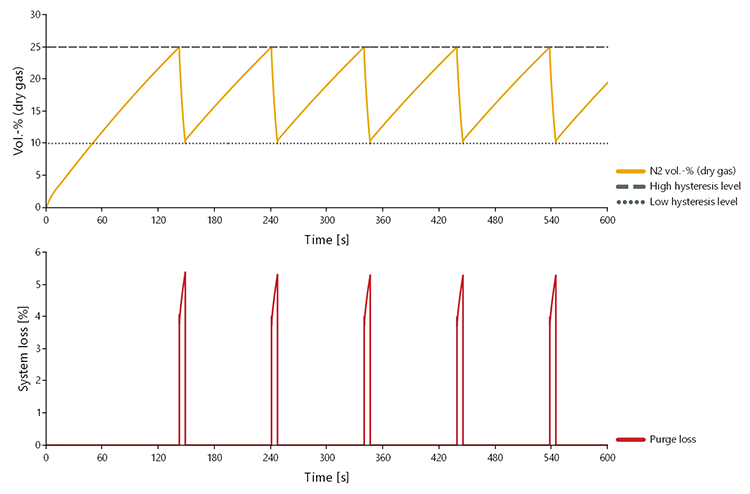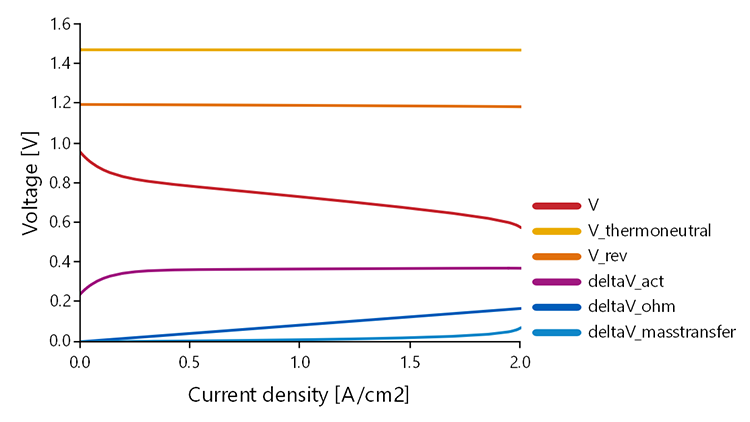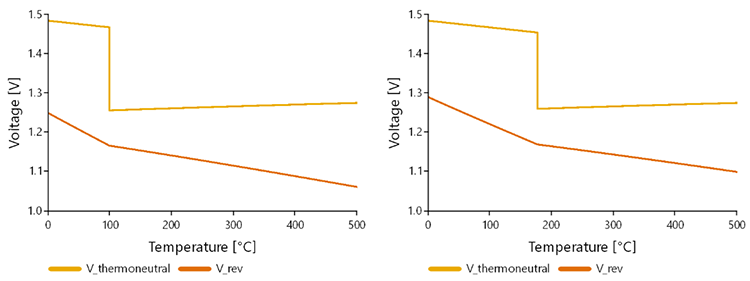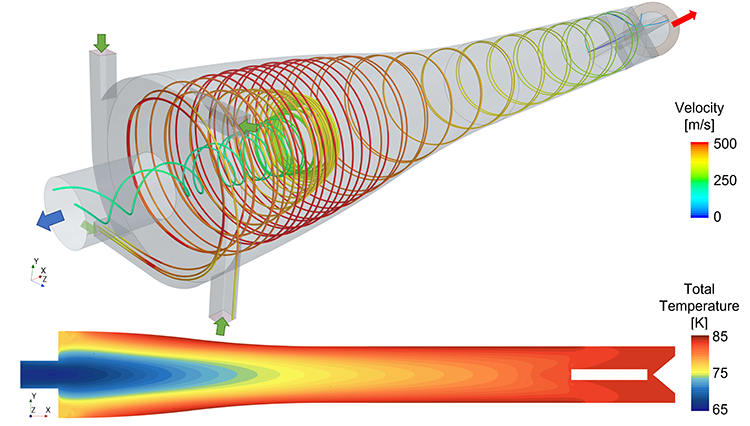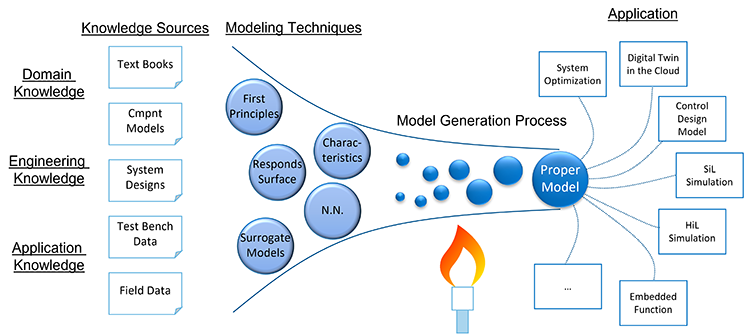Newsletter October 2021
H2 System Simulations
Featuring Fuel Cell, Electrolyzer, Humidifier, Water Separator and other Components
Models for various types of fuel cells and electrolyzers are being developed in our TIL add-on library "Hydrogen Energy Systems". Together with the additionally included balance-of-plant models - for humidifiers, water separators, valves, pipelines as well as various turbomachines - the library enables steady-state and dynamic system simulations all around the fuel cell.
At the heart of the simulation of a fuel cell system - based on our TIL add-on library "Hydrogen Energy Systems" - is a flexible and easy-to-parameterize stack model. Figure 1 shows such a system: The oxygen supply to the stack is provided by a compressor, heat exchanger and humidifier (cathode, figure 1 right). The hydrogen supply includes recirculation and a purge valve to vent undesired nitrogen from the anode (Figure 1, left). The PEM fuel cell stack is operated within the desired temperature range using internal cooling channels and an external cooling system.
Figure 1: Fuel cell system diagram with stack model (center) anode (left) and cathode supply (right) and simple cooling (top).
Due to the numerically robust modeling of the component and system models, such a system can be efficiently simulated under both steady-state and dynamic operating conditions. A highly dynamic example is the purge of the anode circuit with a two-point control. Figure 2 shows the curve of the nitrogen concentration as well as the system loss resulting from the purge over time in an exemplary simulation.
Figure 2: Time curve of the nitrogen concentration in the anode circuit (top) and corresponding system loss resulting from the purge (bottom) obtained from an exemplary simulation.
Flexible base models for PEMFC and SOFC stacks are available in the TIL add-on. These contain basic, fundamental reaction equations of the electrochemical cells. For example, the clamping voltage is calculated based on the reversible cell voltage. To do this, the relevant losses from the activation overvoltage, from the electrical and ionic ohmic overvoltage, and from the mass transfer overvoltage are considered (see Figure 3). For the description of these loss mechanisms as well as the heat, mass and charge transport, exchangeable and expandable correlations are provided. These options allow individual model adaptation and parameterization based on customer-specific requirements.
The calculation and use of thermophysical material properties is indispensable in all models. Thanks to the TILMedia substance data library, chemical and electrochemical reactions in the fuel cell models can be balanced precisely and extremely quickly in terms of energy. Reaction heats as well as thermoneutral and reversible cell voltages as a function of temperature, pressure and concentration can be determined from the stored functions for calculating the Gibbs Energy (see Fig. 4).
Figure 4: Calculation of the thermoneutral and reversible cell voltage of silent water formation at 1 bar (left) and 10 bar (right).
TLK-Thermo can rely on many years of experience from various customer service and research projects for the development of fuel cell stack and system models. Fuel cell simulations and component measurements for the automotive and aerospace sectors are carried out either directly at TLK or also in cooperation with the Institut für Thermodynamik at the Technische Universität Braunschweig. The PEMFC and SOFC stack models of the upcoming October release TIL 3.11 are also based on our many years of programming experience with Modelica in Dymola. In the future, we will develop further types of fuel cell and electrolyzer models, whereby we will be happy to meet your requirements. Please contact us also for other questions in the field of hydrogen, for which we can model, simulate or measure for you.
Contact Hydrogen: Dr. rer. nat. André Thüring
Contact TIL Suite: Dipl.-Ing. Ingo Frohböse
Hydrogen has an increasingly important role in our energy supply. For various applications of storage and transport of H2, precise models are needed to simulate complex phenomena. Using the example of a vortex tube, we show capabilities of 3D field computation, taking into account real-gas behavior at high velocities.
In the future, liquid hydrogen (LH2) will play an important role in the transport, storage, and refueling systems of hydrogen for aircraft and trucks. Efficient processes for cooling and liquefying hydrogen are a fundamental requirement for hydrogen storage. The so-called vortex tube - or a Ranque-Hilsch vortex tube (Figure 1) - is one component suitable for these processes. It is well suited because it has no moving parts and allows an incoming gas stream (green arrows) to be split into two streams with a significant temperature difference (red arrow, blue arrow).
The range of applications of the vortex tube extends from compressed gaseous hydrogen to liquid hydrogen: At hydrogen filling stations, the vortex tube can be used for the conditioning of compressed gaseous hydrogen. For the storage of LH2, it can be applied for boil-off gas reduction as well as liquid subcooling by means of a para-ortho catalyst integrated in the vortex tube (so-called Heisenberg Vortex Tube).
Figure 5: Streamlines of the flow velocity and contour of the temperature in the cross section of the vortex tube.
In order to be able to represent the behavior of the vortex tube with the aid of a 3D flow simulation, we use Star-CCM+. Due to the high flow velocities (approx. 0.8 Ma) on the one hand and the simultaneously low temperatures on the other hand, we use a coupled flow solver with a real gas model according to Redlich-Kwong in Star-CCM+. We use TILMedia to determine the necessary parameters of the material properties at a Para/ortho ratio of 1 to 3.
The results of the simulation are shown in Figure 1. On the basis of the streamlines, the resulting flow field as well as the temperature profile show the expected separation of the mass flows into a cold and a warm flow. This picture agrees qualitatively with the observations from the publications in [2] and [3]. The temperature field calculated in the simulation shows high consistency with the results of the publication by Matveev [1]. The drop in total gas temperature between inlet and cold outlet is 8.94 K in the simulation performed by TLK. This corresponds to the results of Matveev with a deviation of 0.05 K or 0.6%.
The high accuracy of our simulation results provides the basis for system simulations as well as potential analyses for the integration of the vortex tube into the hydrogen industry.
Contact CFD: Dr.-Ing. Björn Flieger
Contact TILMedia: Dipl.-Ing. Ingo Frohböse
[1] Matveev, 2021, Numerical Simulations of Cryogenic Hydrogen Cooling in Vortex Tubes with Smooth Transitions
[2] https://en.wikipedia.org/wiki/Vortex_tube
[3] Taha et al., 2013, Vortex Tube Air Cooling: The Effect on Surface Roughness and Power Consumption in Dry Turning
Development of Modeling Techniques
Efficient Generation of Appropriate Models through Hybrid Approaches
Within the PHyMoS research project, TLK is developing models and methods that allow a purposeful combination of physical and data-based approaches. Hybrid modeling techniques enables flexible solutions – based on the data situation, the necessary speed and the required accuracy.
The aim of the currently running PHyMoS project (Proper Hybrid Models for Smarter Vehicles) is to develop methods and tools for the automated generation of so-called "Proper Models". In this context, the term "proper" refers to achieving the required model accuracy while keeping complexity to a minimum. Proper models can be generated using hybrid modeling methods in which models are combined from physical knowledge and data-based approaches. The consortium of the BMBF-funded project includes three universities (University of Augsburg, TU Braunschweig and FH Bielefeld) and six companies (Bosch, ESI ITI, LTX, Modelon, XRG and TLK), whereby we mainly contribute our knowledge in our core competence field of thermal systems modeling.
When modeled in appropriate detail, purely physical models have high accuracy and good extrapolation properties. They are based on a system of physically motivated equations, which is solved by a suitable simulator. Data-based models, on the other hand, are based on the use of extensive data sets. The modeling techniques used here range from simple polynomial fitting to Machine Learning techniques (e.g. Deep Learning) and model reduction (e.g. using Proper Orthogonal Decomposition - POD). Data-based models compared to physical models often allow a significantly more efficient model evaluation. However, this high computational efficiency is usually accompanied by insufficient extrapolability. A targeted combination of the advantages of both models should lead to a Proper Model.
The PHyMoS project partners are therefore working on hybrid physical-data-based modeling techniques. We develop methods to increase the computational speed of detailed physical models by using data-based approaches. Furthermore, methods to improve the accuracy and range of validity of existing models using both physical and data-based modeling techniques are investigated. For example, the accuracy of a physical model can be increased by adding previously non-modeled phenomena to this model - based on data. On the other hand, the information content of data-based models - and thus also their accuracy and extrapolation capability - can be increased by incorporating physical knowledge. With the help of the methods and tools developed within the framework of PHyMoS, an application-specific optimization of existing models should be made possible.
Figure 6: Process of generating a Proper Model with input mixture and possible applications. [source: Bosch on behalf of consortium PHyMoS]
At TLK, we provide our customers with methods, models and software using open standards. In the future, we also want to use findings from the PHyMoS project and the Proper Models approach. If you have any questions about the project or about modeling thermal systems with Proper Models, please do not hesitate to contact us.
Contact:
